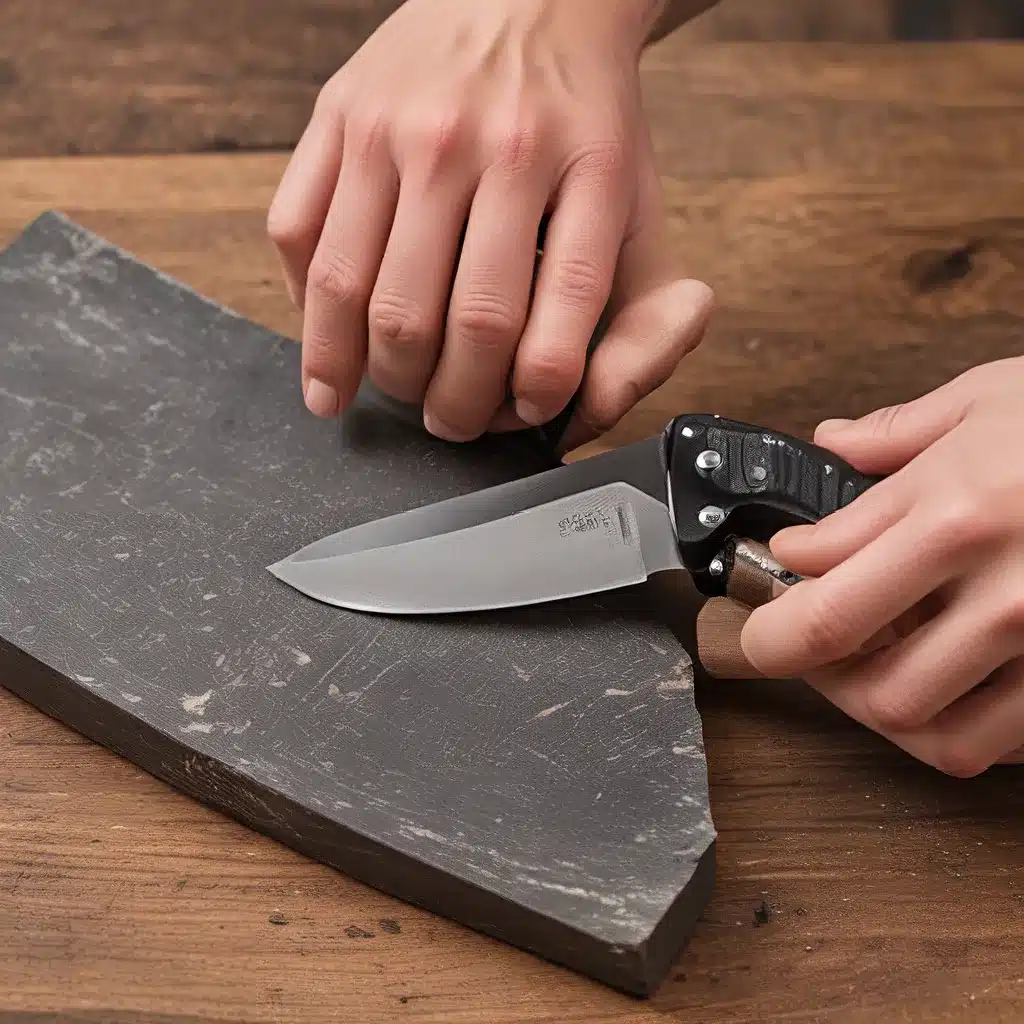
The Sharpening Saga: A Personal Journey
As a self-proclaimed knife enthusiast, I’ve always been fascinated by the art of knife sharpening. It’s a skill that not only transforms a dull, unruly blade into a precise, razor-sharp tool but also serves as a meditative practice, allowing me to connect with the very essence of the knives I use.
My journey into the world of sharpening began quite by accident. I remember the day vividly – I had just prepared a delectable meal, only to be frustrated by the lackluster performance of my trusty chef’s knife. Instead of gliding effortlessly through the ingredients, it stubbornly resisted, leaving me with jagged, uneven cuts. That’s when I knew it was time to take action.
I turned to the experts, eager to learn the secrets of the trade. After hours of poring over instructional videos and manuals, I finally understood the fundamentals of knife sharpening. Armed with a sharpening stone and a keen eye for detail, I set out to transform my trusty blade.
The Art of the Angle: Finding the Sweet Spot
Sharpening a knife is not just about running the blade across a whetstone; it’s a delicate dance of angles, pressure, and technique. The key is to find the optimal sharpening angle, which typically falls between 15 and 20 degrees. Anything less than 15 degrees, and the edge may become too fragile, while anything greater than 20 degrees can result in a duller, less efficient cutting edge.
As I started experimenting, I quickly realized that finding the right angle was like a game of Goldilocks – not too steep, not too shallow, but just right. It took some trial and error, but once I found that sweet spot, the transformation was nothing short of remarkable. The once-dull knife sliced through tomatoes, carrots, and even the toughest of meats with effortless precision.
Sharpening Techniques: From Whetstone to Sharpener
While the whetstone is the traditional tool of choice for knife sharpening, there are now a variety of sharpening devices available to suit every skill level and preference. The WorkSharp Benchstone Knife Sharpener, for instance, offers a user-friendly solution that guides the user through the sharpening process, ensuring a consistent angle and a razor-sharp edge every time.
Regardless of the tool you choose, the key to effective sharpening is to maintain a consistent angle and apply even pressure as you draw the blade across the sharpening surface. It’s also important to pay attention to the position of your fingers to avoid any potential accidents.
As I honed my sharpening skills, I discovered the joy of transforming a dull knife into a precision instrument. The sense of accomplishment I felt when I could effortlessly slice through even the toughest ingredients was simply unparalleled. It was as if I had unlocked a hidden superpower, and I couldn’t wait to share my newfound knowledge with others.
Maintaining the Edge: Prolonging the Perfection
Of course, the journey of knife sharpening doesn’t end with a single session. To keep your blades in tip-top shape, it’s essential to develop a regular sharpening routine. This not only ensures that your knives are always ready for action but also extends their lifespan, saving you time and money in the long run.
One strategy I’ve found particularly effective is to sharpen my knives before they become too dull. By catching the edge early, I can avoid the arduous task of trying to revive an excessively worn blade. Additionally, I make it a point to hone my knives regularly with a sharpening steel or ceramic rod, which helps to realign the edge and maintain its sharpness between full sharpening sessions.
Beyond the Basics: Elevating Your Sharpening Skills
As I continued my sharpening journey, I discovered that there’s always more to learn. From learning to freehand sharpen without the aid of a sharpening guide to mastering the art of edge-leading and edge-trailing techniques, the depth of knowledge in the world of knife sharpening is truly vast.
I’ve even delved into the realm of specialty sharpening stones, each with its own unique grit and purpose, allowing me to fine-tune the edge of my blades to perfection. It’s an endless pursuit of refinement, and I find myself constantly in awe of the small yet significant improvements I can make with each sharpening session.
Embracing the Sharpening Mindset
Knife sharpening is not just a practical skill; it’s a mindset. It’s about understanding the nuances of each blade, respecting its unique properties, and coaxing out its full potential. It’s a practice that requires patience, attention to detail, and a willingness to learn from every sharpening experience.
As I’ve progressed on my sharpening journey, I’ve come to appreciate the meditative quality of the process. There’s something calming and grounding about the rhythmic motion of the blade against the stone, the gentle hiss of the steel, and the gradual transformation of the edge. It’s a practice that not only sharpens my knives but also sharpens my mind, helping me to stay focused, centered, and attuned to the present moment.
Conclusion: Unlocking the Potential of Your Blades
Mastering the art of knife sharpening is a transformative experience. It’s about unlocking the full potential of your blades, elevating your culinary prowess, and connecting with the very essence of the tools you use. Whether you’re a seasoned chef or a home cook, taking the time to sharpen your knives can unlock a world of culinary possibilities.
So, sharpen your skills, sharpen your knives, and embark on your own sharpening journey. Who knows, you might just discover a newfound appreciation for the art of the blade and the joy of slicing through life’s challenges with precision and grace.


